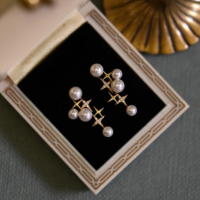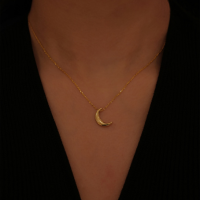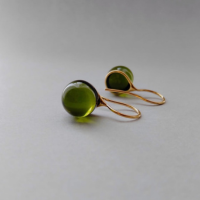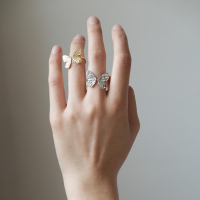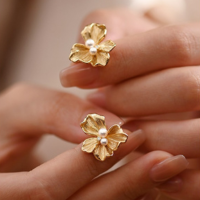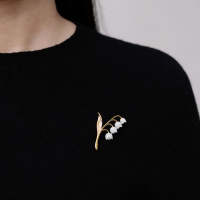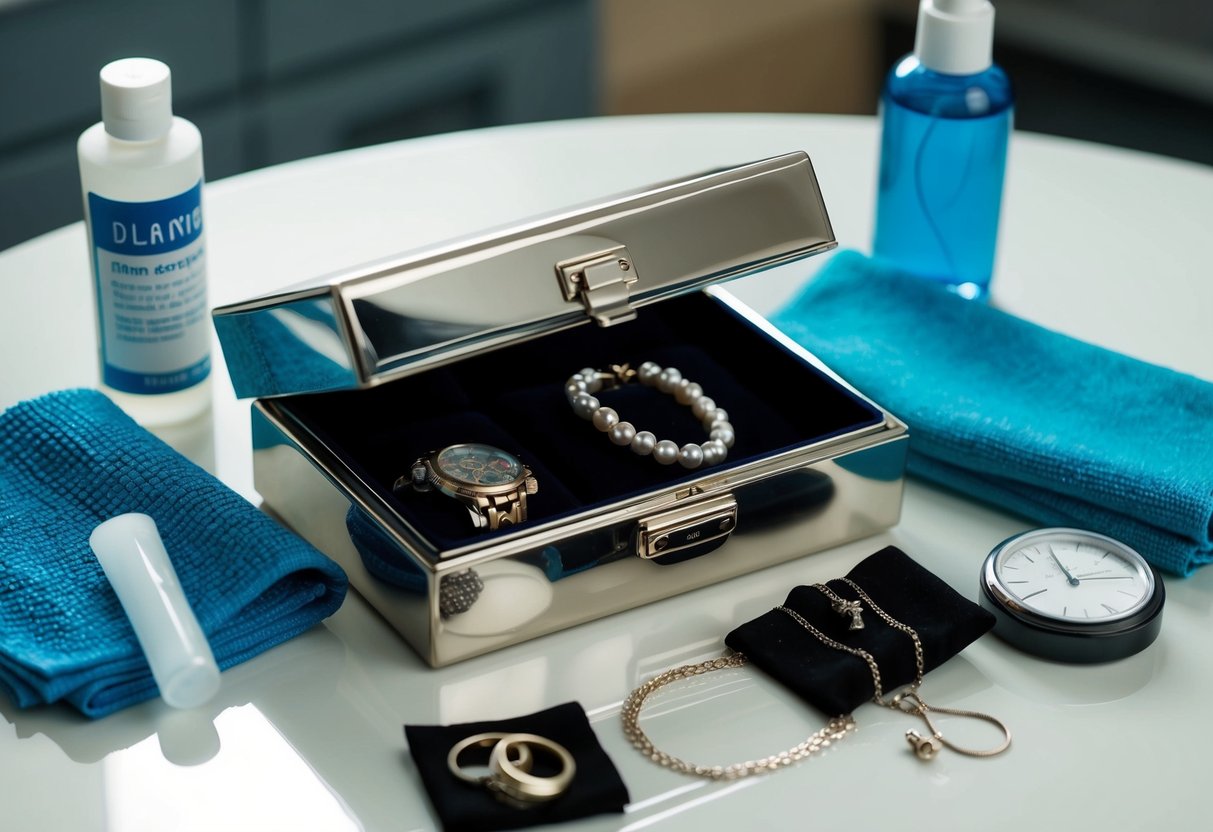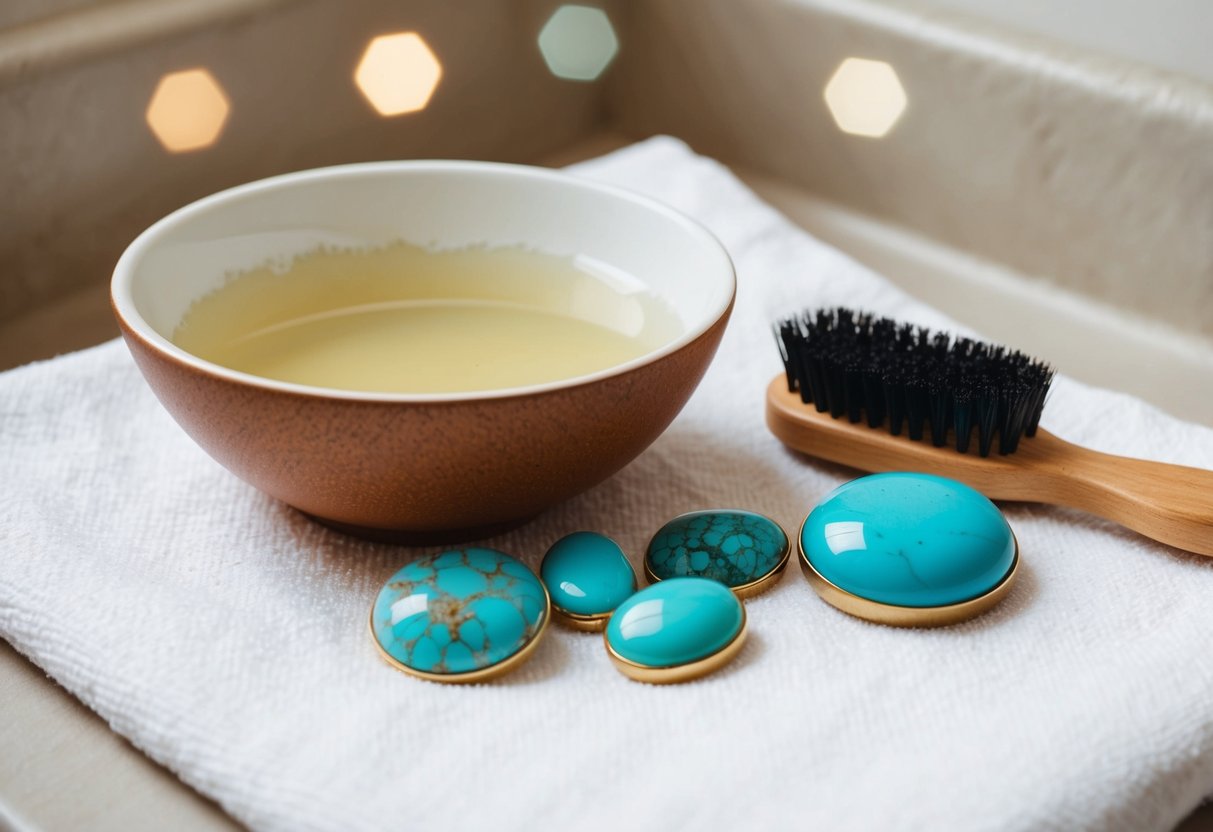
How to Clean Turquoise Jewelry
Check out our personalized jewelry collections! (kids drawing jewelry, coin jewelry, wire jewelry, fingerprint jewelry, handwriting jewelry, and more)
Turquoise jewelry adds a pop of color and flair to any outfit. But, like all precious items, it needs special care to keep it looking its best. To clean turquoise jewelry properly, use a gentle cloth and warm soapy water, avoiding harsh chemicals.
Turquoise is a delicate stone that can easily be damaged by cleaners that are too strong. We should always handle it with care and make sure to dry it thoroughly after cleaning. This helps keep the stone and its setting in great condition.
Maintaining turquoise jewelry is not only about keeping it clean. Regular checks for loose settings and professional cleaning can also be beneficial. It’s an easy way to make sure our pieces stay beautiful for years to come.
Key Takeaways
- Use a gentle cloth and warm soapy water.
- Avoid harsh chemicals and dry the jewelry well.
- Regular checks and professional cleaning are beneficial.
Understanding Turquoise Jewelry
Turquoise jewelry captures our attention with its striking blue and green hues. This stone’s unique characteristics and variety make it a popular choice in fashion accessories.
Characteristics of Turquoise
Turquoise is known for its distinct color ranging from sky blue to green. The color often depends on the amount of iron or copper present. The stone's matrix, a pattern of veins made of other minerals, can create intricate designs that make each piece unique.
Turquoise is a softer gemstone, with a Mohs hardness rating of 5-6. This quality means it's more prone to scratches and nicks. We must handle and store turquoise carefully to maintain its beauty. It's also semi-porous, absorbing oils and liquids, which can lead to discoloration. Therefore, we should avoid exposure to chemicals found in lotions or perfumes.
Value and Varieties
Turquoise comes in different varieties, with colors and patterns adding to its appeal and value. Some pieces might have a uniform color, while others possess a webbed matrix. High-quality turquoise is often more vibrant and free from visible inclusions.
Factors affecting value include origin, matrix presence, and treatment. Natural turquoise is more valued than treated ones since treatments can improve color but might reduce the stone’s originality. Regions like Iran, the United States, and China are renowned for their distinctive turquoise qualities.
Knowing these factors helps us appreciate the worth of turquoise jewelry and make informed buying decisions.
Before You Begin Cleaning
When we set out to clean turquoise jewelry, it's important to first know the quality of the turquoise and gather all the necessary tools for the task. Understanding these aspects ensures we can clean the jewelry safely and effectively without causing damage.
Identifying Turquoise Quality
Before we start cleaning turquoise jewelry, we need to identify its quality. Turquoise varies in hardness and color, affecting how we should clean it.
First, let’s consider if it’s natural or stabilized. Natural turquoise is untreated and tends to be more porous and fragile, requiring special care. Stabilized turquoise, on the other hand, is treated with a resin to increase its durability.
We should also look for other features like wear. Scratches or cracks might indicate more delicate handling is necessary. A magnifying glass can help us spot these details.
Finally, understanding the value is key. Valuable pieces should be cleaned with extra caution or by a professional. This assessment helps us decide how to approach the cleaning process safely.
Gathering Necessary Supplies
It's essential that we gather the right supplies before we start cleaning. Using the proper tools ensures we don’t accidentally damage the turquoise.
Here are the basics we need:
- Soft, lint-free cloth for gentle wiping
- Mild soap for cleaning
- Bowl of lukewarm water to mix the soap
- Toothpicks or cotton swabs for reaching small crevices
Avoid harsh chemicals or abrasive sponges, as they can harm the turquoise. We should also have a soft towel ready to dry the jewelry after washing.
Getting all these supplies together before starting will make the cleaning process smooth and effective.
Basic Cleaning Techniques
To keep our turquoise jewelry sparkling, we need to focus on both dry cleaning and using gentle soap and water. Each method ensures our pieces remain beautiful without damage.
Dry Cleaning Methods
Dry cleaning can be an effective way to clean turquoise jewelry without risking harm. We can use a soft, lint-free cloth to gently rub our jewelry, removing dust and dirt.
For more stubborn debris, a soft toothbrush can be helpful. We lightly brush the jewelry, being careful not to scrub too hard. Another option is using a compressed air canister. It helps blow away particles from intricate parts of the jewelry.
These methods maintain the finish and avoid harsh chemicals. By choosing dry cleaning, we help preserve the natural patina that makes turquoise unique.
Gentle Soap and Water
Sometimes, soap and water are necessary for a deeper clean. We should always use mild soap without strong chemicals. Harsh detergents can be damaging to the stone.
Mix the soap with warm water in a small bowl. We dip a soft cloth into the solution and gently wipe our turquoise piece. Avoid soaking it, as turquoise is porous and excess water can leave stains.
After wiping, we rinse with clean water and dry with a soft cloth, ensuring it’s completely dry before storing. Proper drying prevents water spots and damage, keeping our turquoise looking vivid and bright.
Advanced Cleaning Techniques
When cleaning turquoise jewelry, it's important to address tarnished silver and tough residues. These advanced techniques can restore shine without harming the stone.
Dealing With Tarnished Silver
When silver parts of our turquoise jewelry become tarnished, we should clean them using a gentle approach. We can make a paste from baking soda and water. Simply mix a small amount of baking soda with water until it forms a paste, then apply it to the tarnished areas with a soft cloth.
Rub gently, being careful not to touch the turquoise. Rinse thoroughly with lukewarm water and pat dry with a soft towel. For heavier tarnish, we might try using a silver polishing cloth. Avoid harsh products that could damage the turquoise or the silver finish.
Removing Stubborn Residue
Sometimes, our turquoise jewelry may have stubborn residues that are hard to remove. A practical way to tackle this is by using mild dish soap mixed with lukewarm water. We should soak a soft cloth or brush in the soapy water and gently scrub the affected areas.
Repeat this process until the residue loosens. For more persistent residue, we can dip a cotton swab in a half-water, half-vinegar solution. Carefully apply it to the residue and let it sit for a few minutes before cleaning gently. Always remember to thoroughly rinse and dry the jewelry afterward.
Drying and Buffing
To keep turquoise jewelry looking its best, we need to pay attention to drying and polishing. These steps help maintain its natural beauty and vibrant color.
Proper Drying Procedure
After cleaning, it's crucial to dry turquoise jewelry carefully. We use a soft, lint-free cloth to gently pat the surface dry. Never rub harshly, as this can damage the stone's polish. It's important to make sure all moisture is gone because water can harm turquoise over time.
For intricate pieces, we pay special attention to hidden areas where water might gather. These spots should be dried with a fine cloth or cotton swabs. Lay the jewelry flat on a clean towel, allowing air to circulate and any remaining moisture to evaporate naturally.
Polishing Turquoise
Polishing helps bring out the shine without damaging the jewelry. We use a clean, soft cloth specifically for jewelry polishing. Gently moving the cloth in a circular motion, focus on the stones and metal parts. It's necessary to avoid using any abrasive materials that can scratch the surface.
For a brighter finish, a small amount of non-abrasive jewelry polish can be applied to the cloth. Always test any product on a small, hidden section before applying it to the entire piece. This approach ensures we maintain the luster and elegance of our turquoise jewelry.
Maintenance and Care
Caring for turquoise jewelry keeps it looking vibrant and extends its life. Let's look at how regular cleaning helps maintain its shine, and the best ways to store it safely.
Regular Maintenance Tips
We should clean our turquoise pieces regularly. Turquoise is porous, so harsh chemicals can hurt it. Warm water and a soft cloth work best. Occasionally, dampen the cloth to wipe down each piece gently. Avoid soaking the jewelry, as water can seep in and damage it.
We can also use mild dish soap if needed. Make sure to rinse thoroughly and pat dry with a clean cloth. Polishing the metal parts with a gentle jewelry cloth can add shine without touching the stone.
Storing Your Turquoise Jewelry
Proper storage is key to preserving our jewelry. It's important to keep turquoise away from direct sunlight, as this can cause color fading. Store each piece separately in a soft pouch or lined jewelry box to avoid scratches.
Our jewelry should be stored away from heat and moisture. Avoid leaving it in the bathroom or near windows. Using a silica gel pack can help control humidity levels.
By taking these steps, we can keep our turquoise jewelry looking beautiful for years.
Professional Cleaning and Repair
Taking care of turquoise jewelry is important. Sometimes, it's best to let experts handle cleaning and repairs to avoid damage. We'll cover when you should seek professional help and how to choose a service that's right for your needs.
When to Seek a Professional
Turquoise is a delicate stone. Our jewelry might need professional cleaning if it's very dirty or damaged. Home cleaning can harm the stone if not done properly. Look for signs like deep stains, loose settings, or any visible cracks. These mean it's time for a professional's touch.
Professional cleaners have special tools. They can clean and repair turquoise without hurting it. They might use gentle methods like ultrasonic cleaning or handle repairs with precision. Letting professionals work on your jewelry keeps it looking great and ensures it lasts longer.
Choosing the Right Service
Deciding on the right service for professional cleaning and repair is critical. We should start by checking if the jeweler has experience with turquoise. Ask for recommendations from friends or look at reviews online.
It's important to ensure the jeweler uses gentle cleaning techniques suitable for turquoise. They should also be transparent about their methods and costs. Get a clear idea of what they offer and compare prices. Our jewelry deserves the best care, so choose a reputable service that specializes in handling delicate stones like turquoise.
Frequently Asked Questions
Cleaning turquoise jewelry requires careful methods to protect its beauty and value. We'll cover techniques for silver-turquoise pieces, household cleaning tips, bead maintenance, vintage care, tarnish removal, and restoring luster.
What is the best method to clean silver turquoise jewelry?
We need to clean silver turquoise items gently. A soft cloth and mild soap with warm water can help remove dirt. Avoid using harsh chemicals as they can damage both the stone and the metal setting. Dry the jewelry thoroughly afterward.
Can you clean turquoise stones with household items?
Yes, we can use household items like mild detergent mixed with water to clean turquoise stones. Dampen a soft cloth with this solution and wipe the stones gently. We should avoid vinegar, ammonia, or ultrasonic cleaners, as these can harm the stone’s surface.
How do you care for turquoise beads to maintain their quality?
Turquoise beads need gentle care. We should store them in a cool, dry place away from direct sunlight. When cleaning, use a damp cloth with mild soap. Ensure beads are completely dry before storing them. This helps avoid discoloration and damage.
What are the steps to safely clean vintage Native American turquoise jewelry?
For vintage pieces, we must be extra cautious. Use a soft toothbrush and mild soapy water to clean carefully. Avoid soaking, and pay attention to any intricate designs to prevent wear. Dry with a soft cloth and store in a fabric-lined box.
How can you remove tarnish from turquoise jewelry effectively?
To tackle tarnish, we gently rub the metal parts with a silver polishing cloth. We should keep the cloth away from the turquoise stone to avoid scratching. Refrain from using tarnish removers or chemical dips, as they can harm the stone.
Is it possible to restore the luster of dull turquoise pieces?
Yes, restoring luster is possible. We can rub the stones lightly with a piece of chamois cloth. This simple technique can bring back some shine without risk. It's important not to use oils or waxes, as they can alter the stone's appearance.

